This document provides an overview of NumPy, the fundamental package for scientific computing in Python. It discusses NumPy's powerful N-dimensional array object and sophisticated broadcasting functions. The document outlines topics including Ndarray, creating and manipulating arrays, array properties, basic operations, matrices, and advanced usages like boolean indexing and masking. NumPy allows efficient storage and manipulation of multi-dimensional data, and integration with languages like C/C++ and Fortran.











![Ndarray § shape § ndim § dtype § size § itemsize § data 12 1 2 3 4 5 6 7 8 9 10 11 12 from numpy import * a = array([[ 0, 1, 2, 3, 4], [ 5, 6, 7, 8, 9], [10, 11, 12, 13, 14] ])](https://image.slidesharecdn.com/pythonnumpy-170801154257/75/Scientific-Computing-with-Python-NumPy-WeiYuan-12-2048.jpg)
![Ndarray § shape § ndim § dtype § size § itemsize § data 13 1 2 3 4 5 6 7 8 9 10 11 12 from numpy import * a = array([[ 0, 1, 2, 3, 4], [ 5, 6, 7, 8, 9], [10, 11, 12, 13, 14] ]) a.shape # (3, 5) a.ndim # 2 a.dtype.name # 'int32’ a.size # 15 a.itemsize # 4 type(a) # numpy.ndarray](https://image.slidesharecdn.com/pythonnumpy-170801154257/75/Scientific-Computing-with-Python-NumPy-WeiYuan-13-2048.jpg)

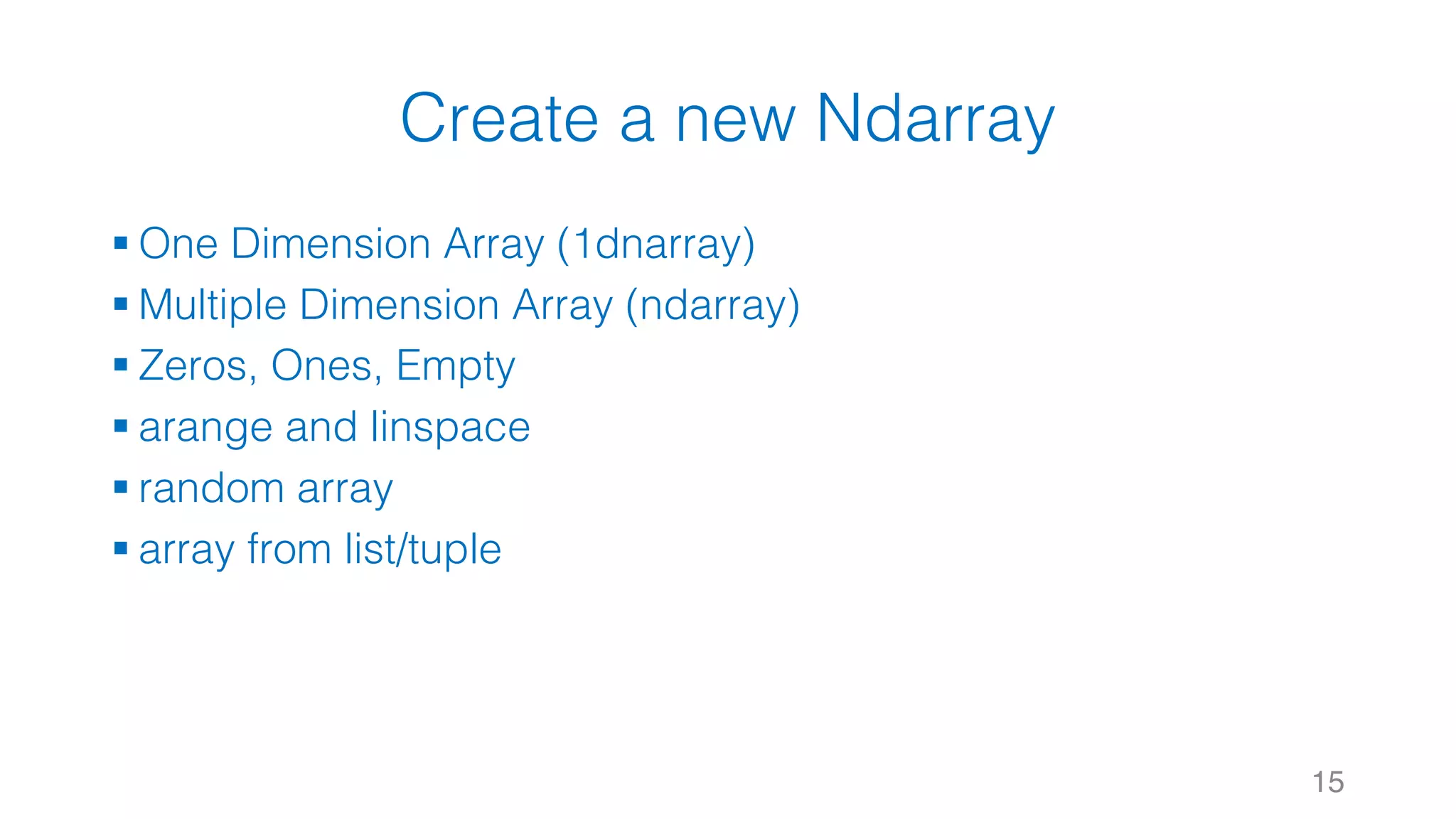
![Create a new Ndarray § One Dimension Array (1dnarray) 16 1 2 3 4 5 6 7 8 9 import numpy as np arr1 = np.array([0, 1, 2, 3, 4]) # array([0 1 2 3 4]) type(arr1) # <type 'numpy.ndarray'> arr1.dtype # dtype('int64') array( )](https://image.slidesharecdn.com/pythonnumpy-170801154257/75/Scientific-Computing-with-Python-NumPy-WeiYuan-16-2048.jpg)
![Create a new Ndarray § One Dimension Array (1dnarray) 17 1 2 3 4 5 6 7 8 9 import numpy as np arr1 = np.array([0, 1, 2, 3, 4]) # array([0 1 2 3 4]) type(arr1) # <type 'numpy.ndarray'> arr1.dtype # dtype('int64') arr2 = np.array([1.2, 2.4, 3.6]) # array([1.2, 2.4, 3.6]) type(arr2) # <type 'numpy.ndarray'> arr2.dtype # dtype('float64') array( )](https://image.slidesharecdn.com/pythonnumpy-170801154257/75/Scientific-Computing-with-Python-NumPy-WeiYuan-17-2048.jpg)

![Create a new Ndarray § Multiple Dimension Array (ndarray) 19 1 2 3 4 5 6 7 8 9 import numpy as np a = np.array([[1, 2, 3], [4, 5, 6]]) # array([[1, 2, 3], # [4, 5, 6]]) array( )](https://image.slidesharecdn.com/pythonnumpy-170801154257/75/Scientific-Computing-with-Python-NumPy-WeiYuan-19-2048.jpg)

![Create a new Ndarray § Zeros, Ones, Empty 21 1 2 3 4 5 6 7 8 9 import numpy as np zeros = np.zeros(5) # array([ 0., 0., 0., 0., 0.]) zeros( )](https://image.slidesharecdn.com/pythonnumpy-170801154257/75/Scientific-Computing-with-Python-NumPy-WeiYuan-21-2048.jpg)
![Create a new Ndarray § Zeros, Ones, Empty 22 1 2 3 4 5 6 7 8 9 import numpy as np zeros = np.ones(5) # array([ 1., 1., 1., 1., 1.]) ones( )](https://image.slidesharecdn.com/pythonnumpy-170801154257/75/Scientific-Computing-with-Python-NumPy-WeiYuan-22-2048.jpg)
![Create a new Ndarray § Zeros, Ones, Empty 23 1 2 3 4 5 6 7 8 9 import numpy as np zeros = np.empty(5) # array([ 0., 0., 0., 0., 0.]) empty( )](https://image.slidesharecdn.com/pythonnumpy-170801154257/75/Scientific-Computing-with-Python-NumPy-WeiYuan-23-2048.jpg)
![Create a new Ndarray § arange and linspace 24 1 2 3 4 5 6 7 8 9 import numpy as np arange = np.arange(5) # array([0 1 2 3 4]) arange( )](https://image.slidesharecdn.com/pythonnumpy-170801154257/75/Scientific-Computing-with-Python-NumPy-WeiYuan-24-2048.jpg)
![Create a new Ndarray § arange and linspace 25 1 2 3 4 5 6 7 8 9 import numpy as np linspace = np.linspace(0, 4, 5) # array([ 0., 1., 2., 3., 4.]) linspace( )](https://image.slidesharecdn.com/pythonnumpy-170801154257/75/Scientific-Computing-with-Python-NumPy-WeiYuan-25-2048.jpg)
![Create a new Ndarray § random array 26 1 2 3 4 5 6 7 8 9 import numpy as np linspace = np.random.randint(0, 2, size=4) # array([ 0, 1, 1, 1]) random.randint( )](https://image.slidesharecdn.com/pythonnumpy-170801154257/75/Scientific-Computing-with-Python-NumPy-WeiYuan-26-2048.jpg)


![Create a new Ndarray § array from list/tuple 29 1 2 3 4 5 6 7 8 9 import numpy as np x = [1,2,3] a = np.asarray(x) x = (1,2,3) a = np.asarray(x) asarray( )](https://image.slidesharecdn.com/pythonnumpy-170801154257/75/Scientific-Computing-with-Python-NumPy-WeiYuan-29-2048.jpg)




![Property of Ndarray § shape § ndim § dtype § size § itemsize § data 34 1 2 3 4 5 6 7 8 9 10 11 12 import numpy as np a = np.array( [[11, 12, 13, 14, 15], [16, 17, 18, 19, 20], [21, 22, 23, 24, 25], [26, 27, 28 ,29, 30], [31, 32, 33, 34, 35] ])](https://image.slidesharecdn.com/pythonnumpy-170801154257/75/Scientific-Computing-with-Python-NumPy-WeiYuan-34-2048.jpg)
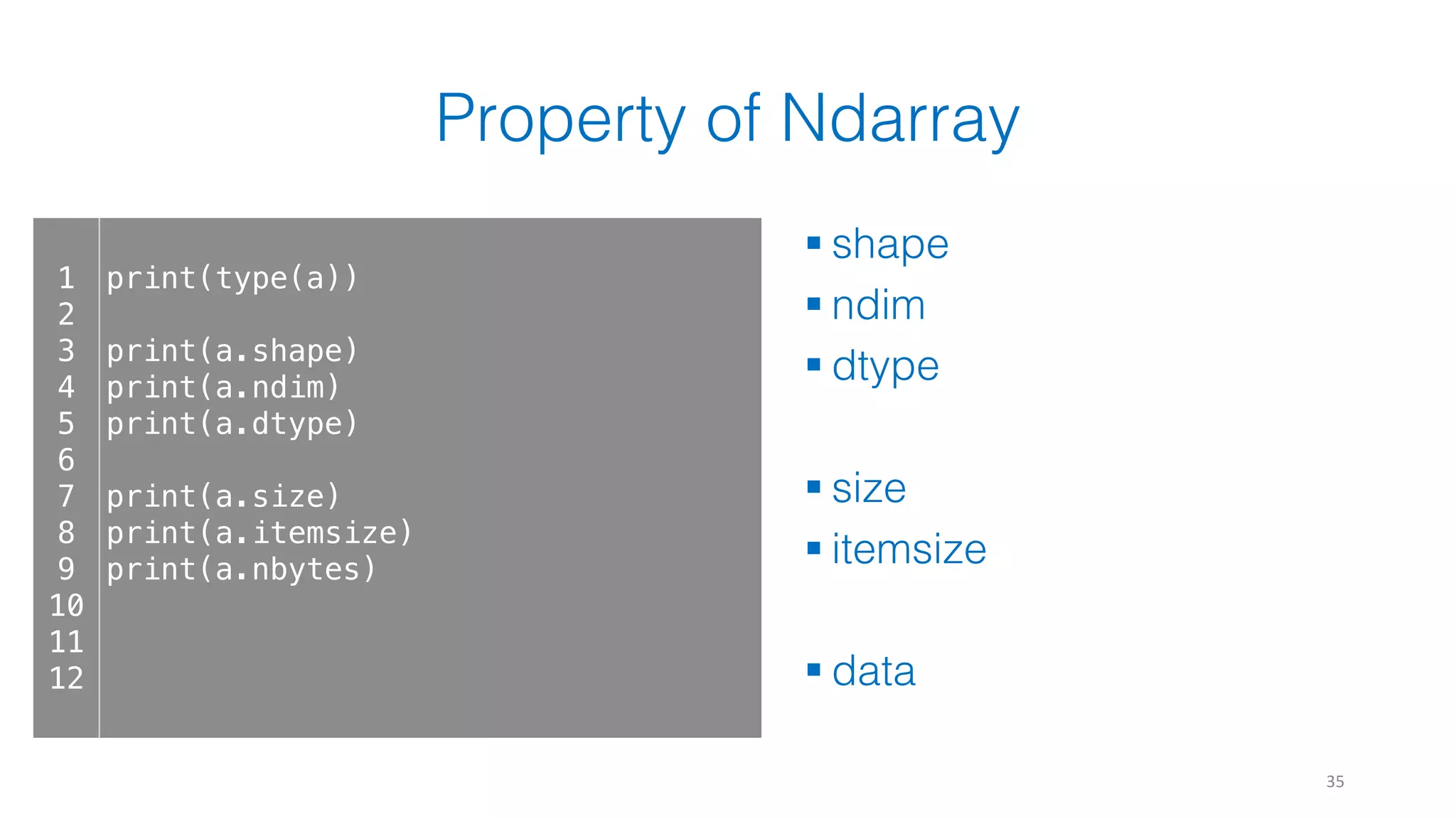

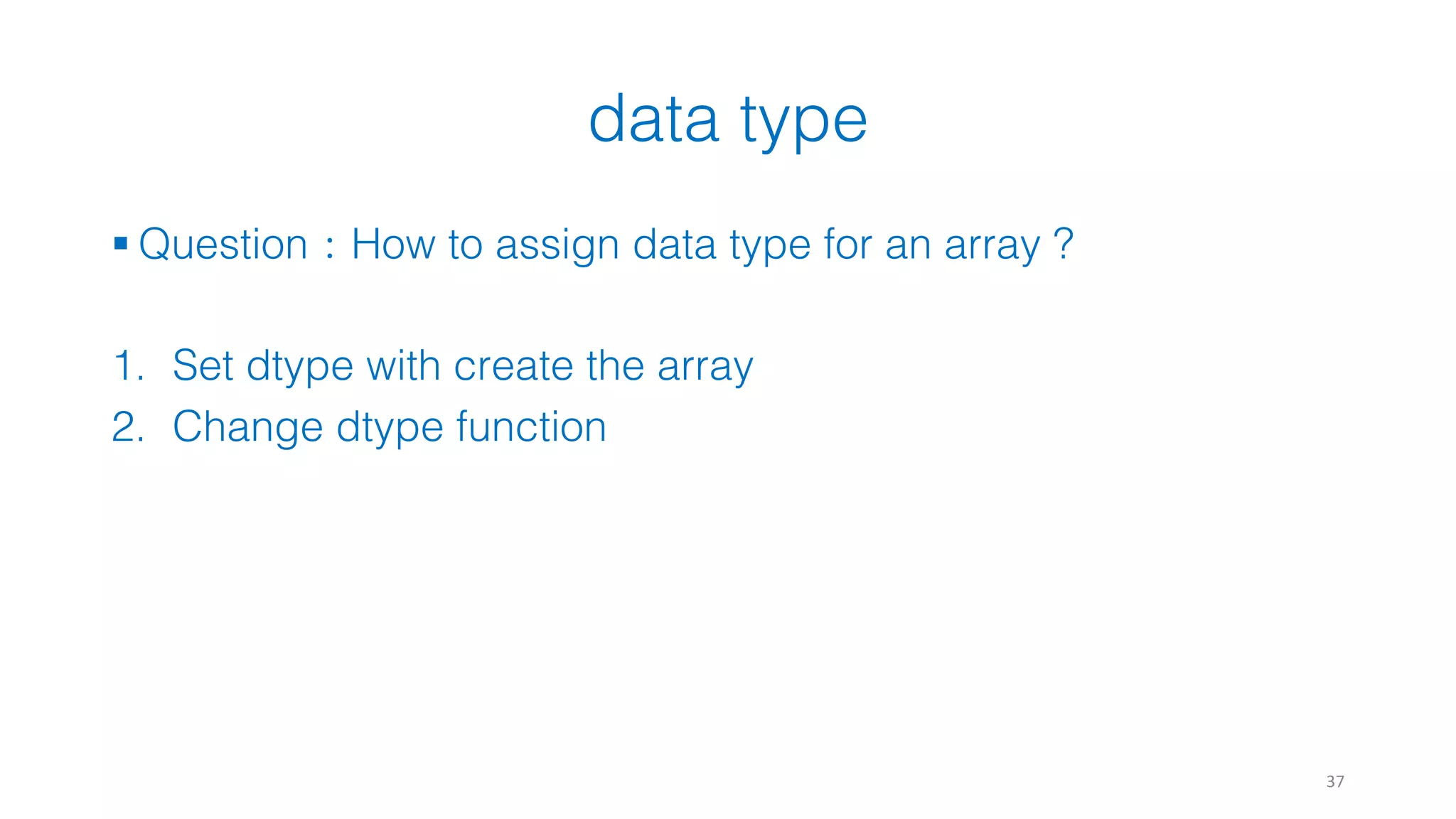
![1. Set dtype with create the array 38 1 2 3 4 5 6 7 8 9 x = numpy.array([1,2.6,3], dtype = numpy.int64) print(x) # print(x.dtype) # x = numpy.array([1,2,3], dtype = numpy.float64) print(x) # print(x.dtype) # array( )](https://image.slidesharecdn.com/pythonnumpy-170801154257/75/Scientific-Computing-with-Python-NumPy-WeiYuan-38-2048.jpg)
![2. Change dtype function 39 1 2 3 4 5 6 7 8 9 x = numpy.array([1,2.6,3], dtype = numpy.float64) y = x.astype(numpy.int32) print(y) # [1 2 3] print(y.dtype) z = y.astype(numpy.float64) print(z) # [ 1. 2. 3.] print(z.dtype) astype( )](https://image.slidesharecdn.com/pythonnumpy-170801154257/75/Scientific-Computing-with-Python-NumPy-WeiYuan-39-2048.jpg)
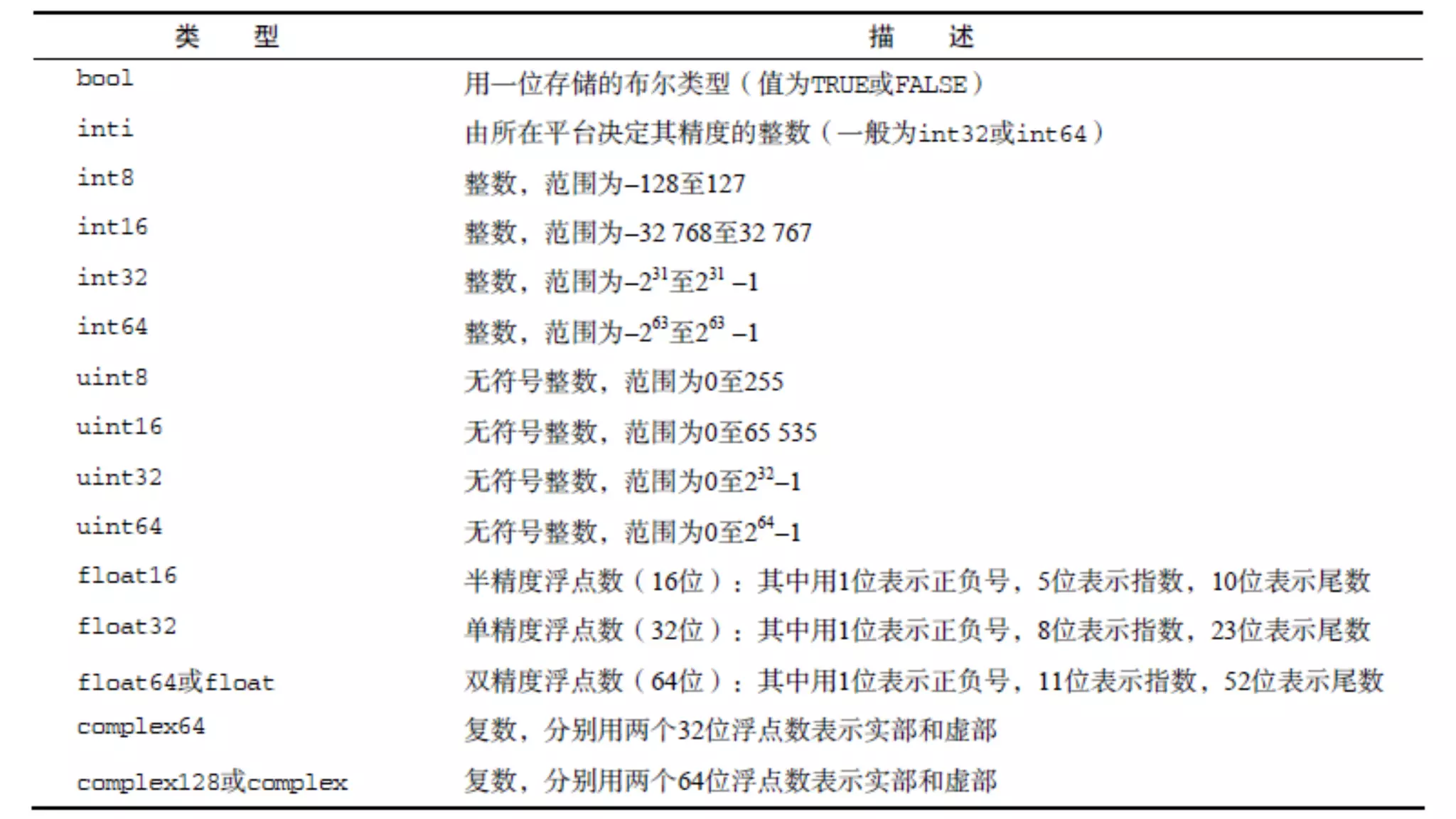
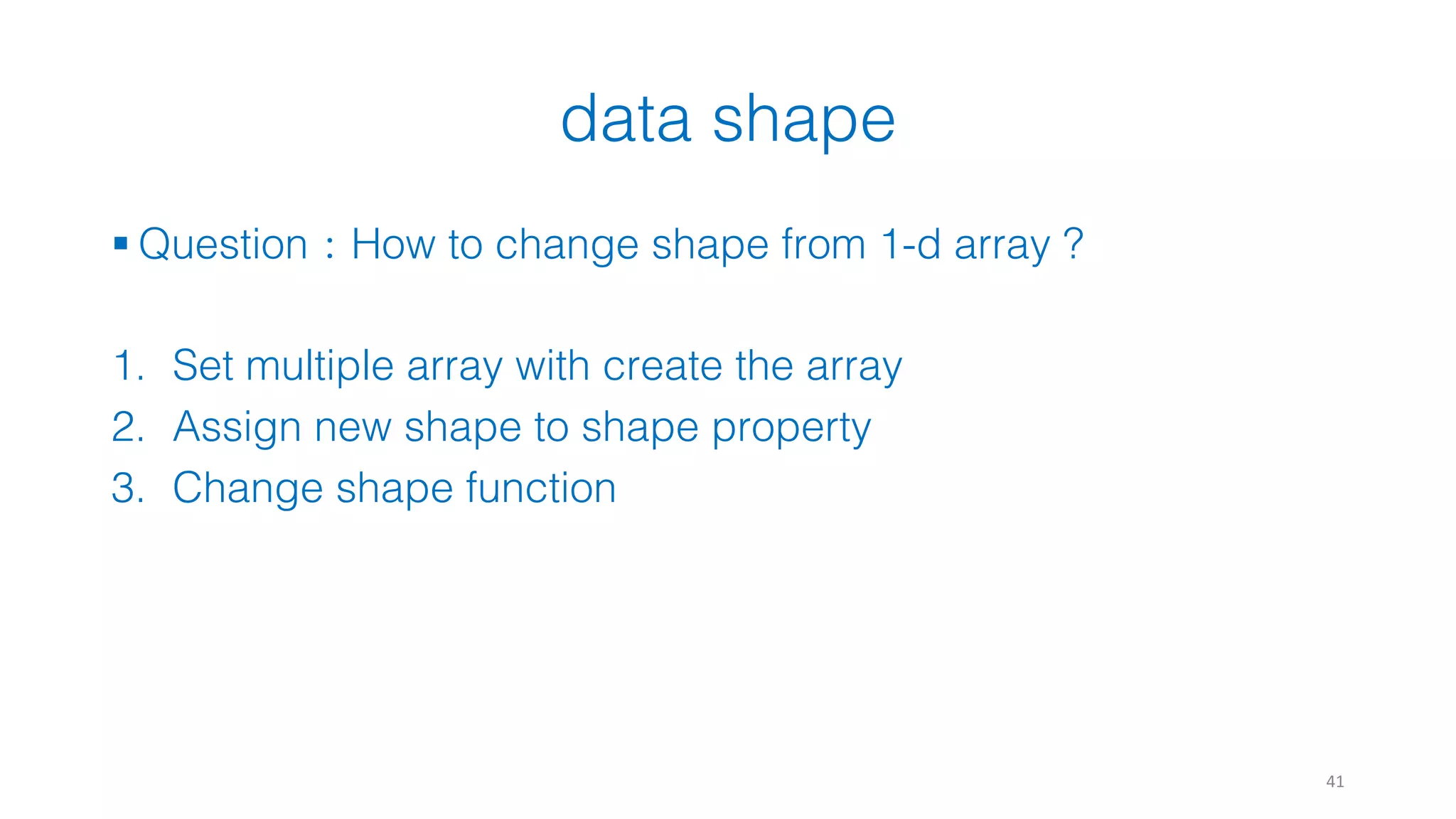
![1. Set multiple array with create the array 42 1 2 3 4 5 6 7 8 9 import numpy as np a = np.array([[1,2,3],[4,5,6]]) a.shape # (2, 3) array( )](https://image.slidesharecdn.com/pythonnumpy-170801154257/75/Scientific-Computing-with-Python-NumPy-WeiYuan-42-2048.jpg)
![2. Assign new shape to shape property 43 1 2 3 4 5 6 7 8 9 a = np.array([[1,2,3],[4,5,6]]) a.shape = (3,2) a # [[1, 2], [3, 4], [5, 6]] array( )](https://image.slidesharecdn.com/pythonnumpy-170801154257/75/Scientific-Computing-with-Python-NumPy-WeiYuan-43-2048.jpg)
![3. Change shape function 44 1 2 3 4 5 6 7 8 9 a = np.array([[1,2,3],[4,5,6]]) b = a.reshape(3,2) b # [[1, 2], [3, 4], [5, 6]] reshape( )](https://image.slidesharecdn.com/pythonnumpy-170801154257/75/Scientific-Computing-with-Python-NumPy-WeiYuan-44-2048.jpg)
![3. Change shape function 45 1 2 3 4 5 6 7 8 9 a = np.array([[1,2,3],[4,5,6]]) b = a.reshape(3,2) b # [[1, 2], [3, 4], [5, 6]] a.resize(3,2) a # [[1, 2], [3, 4], [5, 6]] resize( )](https://image.slidesharecdn.com/pythonnumpy-170801154257/75/Scientific-Computing-with-Python-NumPy-WeiYuan-45-2048.jpg)

![index and slicing § index § slicing 47 1 2 3 4 array[0] # 0 array[1] # 1 array[-1] # 4 1 2 3 4 5 array[1:3] # [1, 2] array[:4] # [0, 1, 3] array[3:] # [3, 4] array[1:4:2] # [1, 3] array[::-1] # [4, 3, 2, 1, 0] ([0, 1, 2, 3, 4])](https://image.slidesharecdn.com/pythonnumpy-170801154257/75/Scientific-Computing-with-Python-NumPy-WeiYuan-47-2048.jpg)
![index and slicing § index § slicing 48 1 2 3 4 array[1] # [0, 1] array[1][0] # 0 array[1][1] # 1 array[2][0] # 2 1 2 3 4 5 array[0:2] # [[0, 1], [2, 3]] array[:2] # [[0, 1], [2, 3]] array[2:] # [[4, 5]] ( [0, 1, 0, 1, 0], [2, 3, 2, 3, 2], [4, 5, 4, 5, 4] )](https://image.slidesharecdn.com/pythonnumpy-170801154257/75/Scientific-Computing-with-Python-NumPy-WeiYuan-48-2048.jpg)
![index and slicing § slicing 49 1 2 3 4 array[0, 1:4] # [1, 0, 1] array[[0, 0, 0], [1, 2, 3]] array[1:3, 0] # [1, 3, 5] array[[1, 2], [0, 0, 0]] ( [0, 1, 0, 1, 0], [2, 3, 2, 3, 2], [4, 5, 4, 5, 4] )](https://image.slidesharecdn.com/pythonnumpy-170801154257/75/Scientific-Computing-with-Python-NumPy-WeiYuan-49-2048.jpg)




![Try it! § #練習: 54 1 2 3 4 5 6 7 8 9 import numpy as np a = np.array([[1,2,3],[3,4,5],[4,5,6]]) # 第二列元素 # 第二行元素 # 除了第二列的元素](https://image.slidesharecdn.com/pythonnumpy-170801154257/75/Scientific-Computing-with-Python-NumPy-WeiYuan-54-2048.jpg)
![Try it! § #練習: 55 1 2 3 4 array[::2,::2] array[:, 1]](https://image.slidesharecdn.com/pythonnumpy-170801154257/75/Scientific-Computing-with-Python-NumPy-WeiYuan-55-2048.jpg)





















